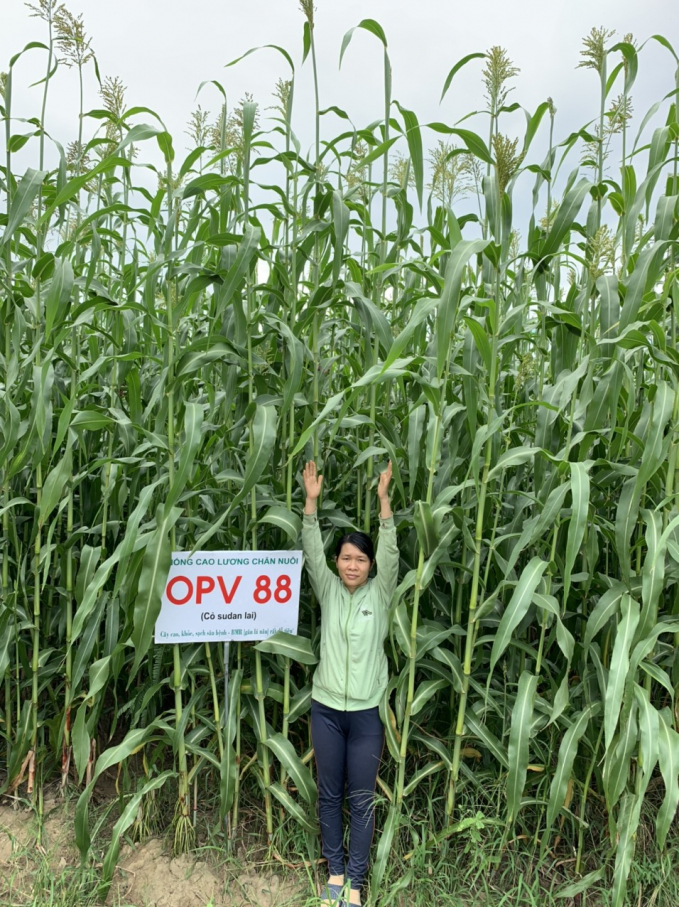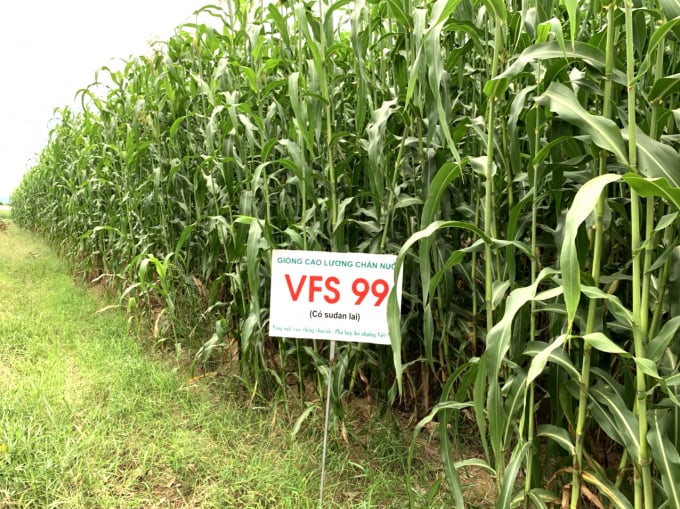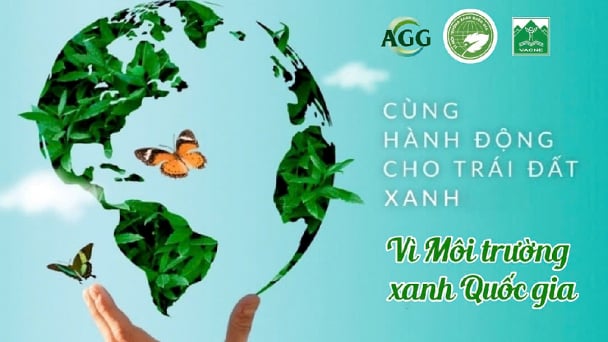May 18, 2025 | 22:12 GMT +7
May 18, 2025 | 22:12 GMT +7
Hotline: 0913.378.918
May 18, 2025 | 22:12 GMT +7
Hotline: 0913.378.918
Introduction video about OPV88 sorghum variety planted by Nha Ho Institute of Cotton Research and Agricultural Development (Ninh Thuan). Source: VNCB.
In the grain crops group, sorghum is the main forage crop (biomass) of many countries around the world due to its very high yield potential, good feed quality, especially good drought tolerance because the leaf surface is covered with a layer of wax and the plant has an osmotic adjustment mechanism to prevent water evaporation.
However, because it is not a native plant, this crop has some weaknesses such as pests infection (especially aphids and cotton diseases), tall trees can fall easily, and yield regeneration is not as expected.
To overcome these weaknesses, since 2019, Nha Ho Cotton Research and Agricultural Development Institute has conducted research on a number of sorghum varieties originating within the country such as OPV88 by the Vietnam Academy of Agriculture (announced for circulation in 2021) and VFS99 of Viet Seed Company Limited (VietSeed).

OPV88 sorghum variety is suitable for dry areas in Ninh Thuan, the height pre-flowering is from 3 to 3.5 m, the yield is over 100 tons/ha/year. Photo: NVS.
Observation results and measurement at the OPV88 sorghum field planted in the summer-autumn crop of 2021 in Ninh Thuan at 65 days old showed that the plants grew very well, with lush green leaves, tripod roots, and free from pests and diseases.
The height of the tree before flowering is from 3 to 3.5 m, each plant lays 2-3 branches, the average diameter of the stem is 3.4 cm. The weight of 1 cluster weighed nearly 1.7 kg, with a planting density of 60x15 cm (about 11.1 thousand clusters/ha), the theoretical biomass yield reached 188.7 tons/ha/crop. In fact, many crops prove that, when planted in the summer-autumn and autumn-winter crops, the yield can easily reach over 100 tons/ha/year.
Introduction video to the sorghum variety VFS99 planted by Nha Ho Institute of Cotton Research and Agricultural Development (Ninh Thuan). Source: VNCB.
Similarly, the VFS99 variety grows well, flowers 5-7 days later compared to OPV88, the plants are green and mostly free of pests. The average tree height before flowering is 3.2 - 3.8 m, each tree lays 3-4 branches, the average diameter of the stem is 2.7 cm. Each cluster weighs 1.53 kg. The actual yield of biomass is more than 100 tons/ha/crop.
Sorghum forage is of very high quality. The stems are sweet, soft, and contain water. The tree has many leaves, the leaves are large and long (9 cm wide, 90 cm long), soft, smooth, hairless. The leaves are easy to chop, silage or feed fresh.
Sorghum can be harvested before flowering for direct feeding or chopping. Harvesting for silage is the best food reserve when the plants have flowered and the seeds are at the waxy ripening stage, if tharvested earlier, they need to be withered to below 65% moisture before chopping and marinating to ensure feed quality.

VFSS sorghum variety is also a very good choice for animal feed, the stems are sweet, soft, and have high nutritional content. Photo: NVS.
Master Nguyen Van Son (Nha Ho Institute of Cotton Research and Agricultural Development) said: The results of multi-crop experiments from 2019 at the Institute for OPV88 and VFS99 varieties show that these domestically produced varieties has overcome the weaknesses and has good resistance to pests and diseases, especially aphids and diseases on cotton.
The tree has a strong, well-developed tripod root system, better resistance to falling than imported varieties and is very suitable for ecological conditions in arid locales such as Ninh Thuan. If sown in the summer-autumn, autumn-winter crops, the plant will flower late, the height can grow continuously to more than 3.5m and give a very high biomass yield of over 100 tons/ha.
However, it is not recommended to plant in windy areas where trees will easily fall at the end of the season or can be overcome by harvesting as soon as the biomass yield is expected without waiting for the tree to be too tall.

Two new varieties of sorghum with tripod roots, strong plants, very good fall resistance, are promising choices to develop as forage for grazing cattle in our country. Photo: NVS.
Sowing in winter-spring crop, spring-summer plants will flower early, plant height will be lower, good fall resistance, but biomass yield will be lower. After harvesting, to regenerate within 1-2 crops, however, the yield will be significantly reduced and should only be used if the remaining time is not enough for a new crop.
The research team has also determined the quality criteria for forage and developed a technical process for planting, using biomass and taking seeds to help recommend the most effective farming method.
Translated by Nguyen Hai Long

(VAN) 14 out of 35 domesticated elephants in Dak Lak province have had their living conditions improved, with 11 of them currently participating in the non-riding elephant tourism model.

(VAN) Muong Nhe Nature Reserve hopes that being upgraded to a national park will lay the foundation for forest protection efforts to be carried out in a systematic, modern, and sustainable manner.
/2025/05/16/3923-2-171845_52.jpg)
(VAN) Lower costs, higher yields, and improved soil quality are outstanding benefits that soybeans bring when integrated into the crop rotation system.

(VAN) The 'For a Green National Environment' programme aims to promote a green lifestyle, support businesses in implementing ESG practices, and turn Net Zero commitments into concrete actions.

(VAN) Cold-barn systems efficiently manage environmental and temperature conditions, which aids in the prevention of respiratory diseases in pigs and protects them from the vectors that transmit African swine fevers.

(VAN) To tackle challenges, the project 'Addressing key technical bottlenecks in the grouper supply chain in Vietnam' has been underway since 2024.

(VAN) The project 'Disease-Resilient and Sustainable Cassava Production Systems in the Mekong Region', funded by the Australian Center for International Agricultural Research (ACIAR), is being implemented from 2024 to 2028.